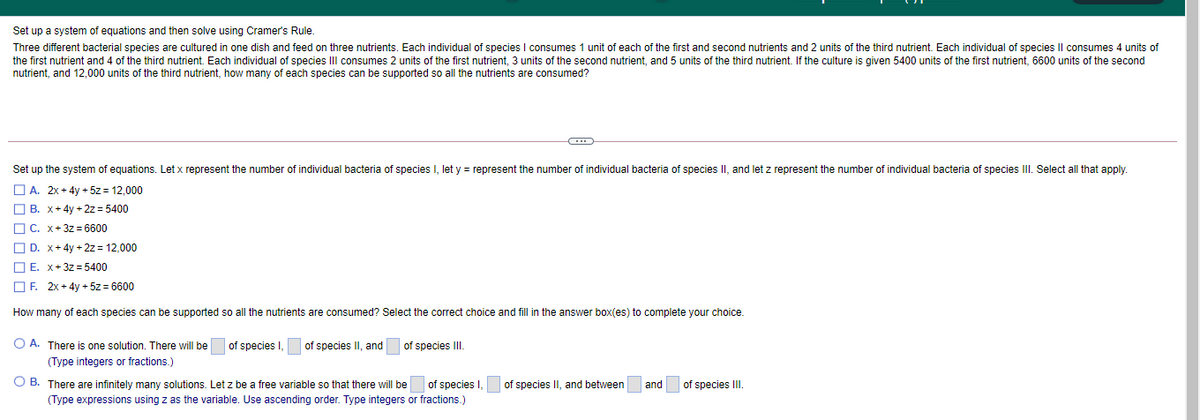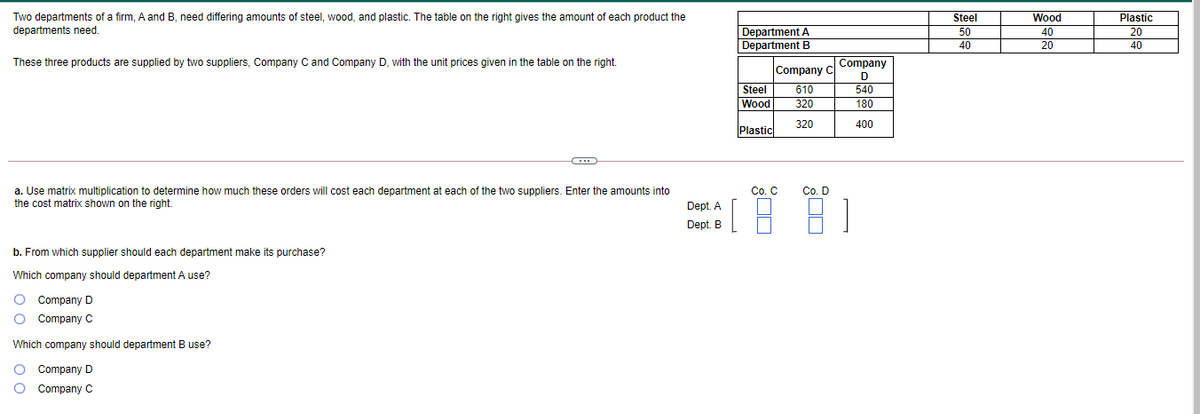Three different bacterial species are cultured in one dish and feed on three nutrients. Each individual of species I consumes 1 unit of each of the first and second nutrients and 2 units of the third nutrient. Each individual of species Il consumes 4 units of the first nutrient and 4 of the third nutrient. Each individual of species III consumes 2 units of the first nutrient, 3 units of the second nutrient, and 5 units of the third nutrient. If the culture is given 5400 units of the first nutrient, 6600 units of the second nutrient, and 12,000 units of the third nutrient, how many of each species can be supported so all the nutrients are consumed? Set up the system of equations. Let x represent the number of individual bacteria of species I, let y = represent the number of individual bacteria species II, and let z represent the number individual bacteria species III. Select all that apply. O A. 2x + 4y + 5z = 12,000 O B. x+4y + 2z = 5400 O C. x+3z = 6600 O D. x+4y + 2z = 12,000 O E. x+3z = 5400 OF. 2x + 4y + 5z = 6600 How many of each species can be supported so all the nutrients are consumed? Select the correct choice and fill in the answer box(es) to complete your choice. O A. There is one solution. There will be of species I, of species II, and of species II. (Type integers fractions.) O B. There are infinitely many solutions. Let z be a free variable so that there will be of species I, of species II, and between and of species III. (Type expressions using z as the variable. Use ascending order. Type integers or fractions.)
Three different bacterial species are cultured in one dish and feed on three nutrients. Each individual of species I consumes 1 unit of each of the first and second nutrients and 2 units of the third nutrient. Each individual of species Il consumes 4 units of the first nutrient and 4 of the third nutrient. Each individual of species III consumes 2 units of the first nutrient, 3 units of the second nutrient, and 5 units of the third nutrient. If the culture is given 5400 units of the first nutrient, 6600 units of the second nutrient, and 12,000 units of the third nutrient, how many of each species can be supported so all the nutrients are consumed? Set up the system of equations. Let x represent the number of individual bacteria of species I, let y = represent the number of individual bacteria species II, and let z represent the number individual bacteria species III. Select all that apply. O A. 2x + 4y + 5z = 12,000 O B. x+4y + 2z = 5400 O C. x+3z = 6600 O D. x+4y + 2z = 12,000 O E. x+3z = 5400 OF. 2x + 4y + 5z = 6600 How many of each species can be supported so all the nutrients are consumed? Select the correct choice and fill in the answer box(es) to complete your choice. O A. There is one solution. There will be of species I, of species II, and of species II. (Type integers fractions.) O B. There are infinitely many solutions. Let z be a free variable so that there will be of species I, of species II, and between and of species III. (Type expressions using z as the variable. Use ascending order. Type integers or fractions.)
Algebra for College Students
10th Edition
ISBN:9781285195780
Author:Jerome E. Kaufmann, Karen L. Schwitters
Publisher:Jerome E. Kaufmann, Karen L. Schwitters
Chapter11: Systems Of Equations
Section11.CT: Test
Problem 24CT
Related questions
Question
Please I need an expert to help me with the solution to this 2 question. i will really appreciate it, thank you.

Transcribed Image Text:Set up a system of equations and then solve using Cramer's Rule.
Three different bacterial species are cultured in one dish and feed on three nutrients. Each individual of species I consumes 1 unit of each of the first and second nutrients and 2 units of the third nutrient. Each individual of species II consumes 4 units of
the first nutrient and 4 of the third nutrient. Each individual of species III consumes 2 units of the first nutrient, 3 units of the second nutrient, and 5 units of the third nutrient. If the culture is given 5400 units of the first nutrient, 6600 units of the second
nutrient, and 12,000 units of the third nutrient, how many of each species can be supported so all the nutrients are consumed?
Set up the system of equations. Let x represent the number of individual bacteria of species I, let y = represent the number of individual bacteria of species II, and let z represent the number of individual bacteria of species III. Select all that apply.
O A. 2x + 4y + 5z = 12,000
O B. x+4y + 2z = 5400
O C. x+3z = 6600
O D. x+4y + 2z = 12,000
O E. X+3z = 5400
O F. 2x+ 4y + 5z = 6600
How many of each species can be supported so all the nutrients are consumed? Select the correct choice and fill in the answer box(es) to complete your choice.
O A. There is one solution. There will be
of species I,
of species II, and
species II.
(Type integers
fractions.)
O B. There are infinitely many solutions. Let z be a free variable so that there will be of species I,
of species II, and between
and
of species II.
(Type expressions using z as the variable. Use ascending order. Type integers or fractions.)

Transcribed Image Text:Two departments of a firm, A and B, need differing amounts of steel, wood, and plastic. The table on the right gives the amount of each product the
departments need.
Steel
Wood
Plastic
Department A
Department B
50
40
20
40
20
40
These three products are supplied by two suppliers, Company C and Company D, with the unit prices given in the table on the right.
Company
Company C
D
Steel
Wood
610
320
540
180
320
400
Plastic
Co. C
Co. D
a. Use matrix multiplication to determine how much these orders will cost each department at each of the two suppliers. Enter the amounts into
the cost matrix shown on the right.
Dept. A
Dept. B
b. From which supplier should each department make its purchase?
Which company should department A use?
Company D
Company C
Which company should department B use?
Company D
Company C
Expert Solution
This question has been solved!
Explore an expertly crafted, step-by-step solution for a thorough understanding of key concepts.
This is a popular solution!
Trending now
This is a popular solution!
Step by step
Solved in 5 steps with 4 images

Recommended textbooks for you

Algebra for College Students
Algebra
ISBN:
9781285195780
Author:
Jerome E. Kaufmann, Karen L. Schwitters
Publisher:
Cengage Learning

Algebra for College Students
Algebra
ISBN:
9781285195780
Author:
Jerome E. Kaufmann, Karen L. Schwitters
Publisher:
Cengage Learning